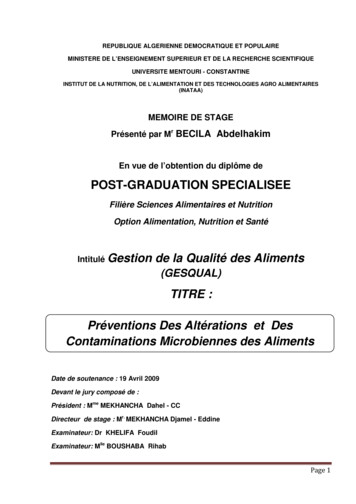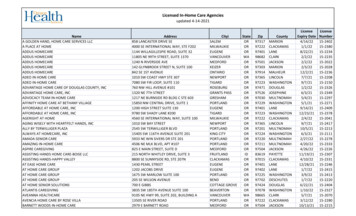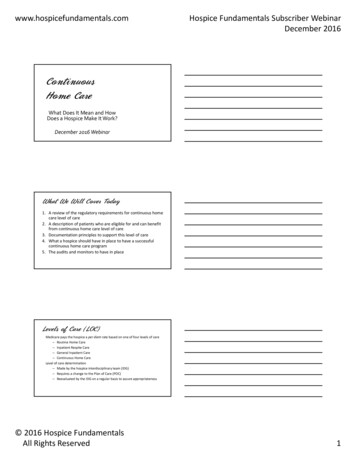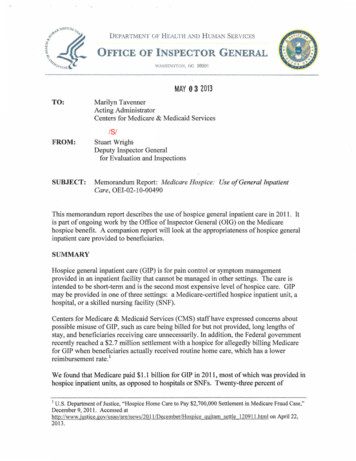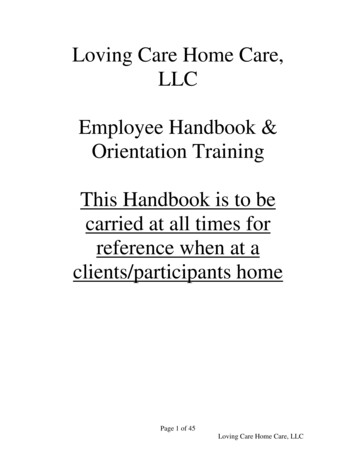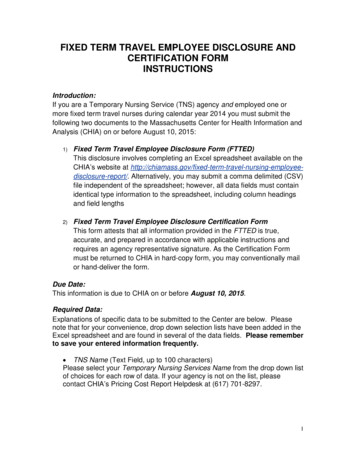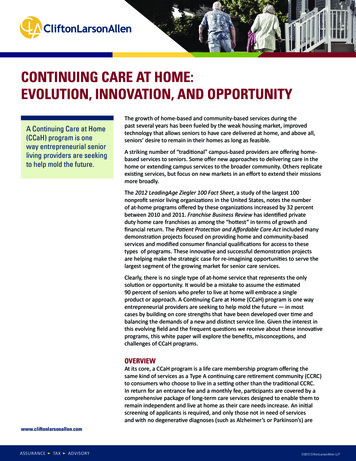
Transcription
CONTINUING CARE AT HOME:EVOLUTION, INNOVATION, AND OPPORTUNITYA Continuing Care at Home(CCaH) program is oneway entrepreneurial seniorliving providers are seekingto help mold the future.The growth of home-based and community-based services during thepast several years has been fueled by the weak housing market, improvedtechnology that allows seniors to have care delivered at home, and above all,seniors’ desire to remain in their homes as long as feasible.A striking number of “traditional” campus-based providers are offering homebased services to seniors. Some offer new approaches to delivering care in thehome or extending campus services to the broader community. Others replicateexisting services, but focus on new markets in an effort to extend their missionsmore broadly.The 2012 LeadingAge Ziegler 100 Fact Sheet, a study of the largest 100nonprofit senior living organizations in the United States, notes the numberof at-home programs offered by these organizations increased by 32 percentbetween 2010 and 2011. Franchise Business Review has identified privateduty home care franchises as among the “hottest” in terms of growth andfinancial return. The Patient Protection and Affordable Care Act included manydemonstration projects focused on providing home and community-basedservices and modified consumer financial qualifications for access to thesetypes of programs. These innovative and successful demonstration projectsare helping make the strategic case for re-imagining opportunities to serve thelargest segment of the growing market for senior care services.Clearly, there is no single type of at-home service that represents the onlysolution or opportunity. It would be a mistake to assume the estimated90 percent of seniors who prefer to live at home will embrace a singleproduct or approach. A Continuing Care at Home (CCaH) program is one wayentrepreneurial providers are seeking to help mold the future — in mostcases by building on core strengths that have been developed over time andbalancing the demands of a new and distinct service line. Given the interest inthis evolving field and the frequent questions we receive about these innovativeprograms, this white paper will explore the benefits, misconceptions, andchallenges of CCaH programs.OverviewAt its core, a CCaH program is a life care membership program offering thesame kind of services as a Type A continuing care retirement community (CCRC)to consumers who choose to live in a setting other than the traditional CCRC.In return for an entrance fee and a monthly fee, participants are covered by acomprehensive package of long-term care services designed to enable them toremain independent and live at home as their care needs increase. An initialscreening of applicants is required, and only those not in need of servicesand with no degenerative diagnoses (such as Alzheimer’s or Parkinson’s) arewww.cliftonlarsonallen.comASSURANCETAXADVISORY 2012 CliftonLarsonAllen LLP
appropriate for the program. Access to services istypically related to a deficit in at least one of five toseven activities of daily living.Members may also receive referrals to a developednetwork of pre-screened, preferred providers of servicesthat are not paid for by the CCaH program, such as homemaintenance, lawn care, or housekeeping. Dependingupon the excess capacity of campus departments, thisreferral network may be comprised of a combination ofsub-contracted vendors as well as services provided andmanaged by the sponsor’s campus departments, thusdriving additional revenue to the sponsor/campus.The package of services is designed to address the social,spiritual, recreational, and health needs of members,and is comprehensive in nature, often including thefollowing: Care coordinationHome inspectionsAnnual physicalAccess to campus amenities and servicesSocial and educational opportunitiesEmergency response systemHomemaker and personal care servicesHome nursingLive-in servicesMealsTransportationAdult day programAssisted living and nursing home facilitiesReferrals for home maintenance, housekeeping, lawncare, etc.The pricing structure of CCaH programs is a life caremodel, offering a member a lifetime guarantee of carefor a one-time entry fee and monthly fees that begin thefirst month of membership. Entry fees increase based onthe age of a person when he/she joins the program. Themonthly fees are designed to increase annually to reflectthe overall operating experience and the cost of living,but typically do not increase as a member needs care,thus protecting a member from “spending down” assets.Sound actuarial pricing is key when operating a CCaHprogram. An actuarial study should include: A clear definition of the package of services and theircosts The criteria a member must meet to qualify forservices A clear articulation of when entrance fees arerefundable The cost of administrative staff and related expenses The daily cap on expenses Estimated future utilization of servicesInnovative technologies, along with traditional serviceoptions, support members in their homes for as longas possible. Some, but not all, CCaH programs offermembers access to the amenities on campus, such asdining, fitness, and social activities. Most of the existingprograms also offer a range of social programs to fosterrelationships and support among members. Services maybe provided by sponsoring organization employees or bysub-contracted vendors that are credentialed to ensurequality operating standards.Usually, a 5 – 15 percent margin is included in the pricingformula, which serves as a “risk buffer” in the eventof adverse experience. However, the actual amountshould be based on the number of members anticipatedand the contract design. While basic Type A contractspredominate, a consumer may be offered a choice ofpricing options that may include:Care coordination is critical to member satisfactionand program success. Each member is assigned a carecoordinator who is typically available to meet him/her atthe start of program membership. The care coordinatorgets to know each member personally, and, as a resultof developing a positive, trusting relationship, becomesa valued advocate when a member’s health changes.It is the care coordinator who will regularly assess amember’s health and functional status, recommendneeded services, and obtain and manage those serviceson behalf of the member. The care coordinator willhelp alleviate the burden of care from families for theirloved ones and, with the member’s permission, cancommunicate regularly with family members.www.cliftonlarsonallen.com A variety of co-pays for future servicesHome care onlyLong-term care insurance (LTCi) policy creditLimited total life-time benefit amountRefundable membership feeOne program has designed a pricing approach thatincorporates an entrance fee paid over time. This sameprogram offers a variety of pricing options similar to LTCi,including several benefit period options, daily expensecaps, and elimination periods.2 2012 CliftonLarsonAllen LLP
CCaH programs have the potential to financially benefitthe sponsoring organization’s campus and its residents inmany ways:CCaH concept is fairly young, the actuarial firm musthave experience with CCRCs, CCaH programs, and LTCi.The importance of LTCi data cannot be understated.LTCi companies typically offer a variety of policies andhave longer and older policyholder data. This diverseexperience helps to validate assumptions related tofuture utilization of services. An additional program spreads out administrativecosts for shared services such as management, humanresources, financial management, billing, and accountspayable and receivable. CCaH programs can increase occupancy of assistedliving and nursing home beds (although this may bemodest because effective care management protocolscan provide substitute services in a member’s home).Reimbursements are paid to the campus by the CCaHprogram at the private pay rate. CCaH progams tend to increase nursing homeoccupancy for Medicare Part A short-term rehab stays. CCaH programs provide rental payments for use ofspace and amenities. Program members increase the utilization of ancillaryservice lines such as home care, home health, andadult day care. A modest number of members may move from theCCaH program to independent living.Bob Yee, principal and consulting actuary for DaVinciConsulting Group of Yardley, Pennsylvania, stated in arecent interview that his firm is not concerned by thelack of CCaH program data because of the depth of LTCidata that his firm uses. Yee said he understands theperceived risk regarding predicting future utilization fora fairly young product that has a large percentage ofyounger members.“We feel we are well equipped to adequately price thisproduct because of the size of our LTCi database, andthe similarities that we see between CCaH members’and LTCi policyholders’ utilization of services,” explainedYee. “The main difference between the two productsis that care management is provided on an ongoingbasis for CCaH members starting from the initialenrollment, and only provided at the time of a claimfor LTCi policyholders. The ongoing care managementis essentially a ‘pre-paid’ service whose cost can bereasonably estimated.”frequently asked questionsabout CCah ProgramsCCaH programs have existed for more than 20 years.While the early research was well covered by the fieldover the past decade, little has been written about theprogress of the early programs and their subsequentdevelopment. Consequently, we frequently fieldquestions about how these programs work.Yee also said he recognized that the relatively small sizeof CCaH program data is an issue, but he believes thatby tapping current CCaH experience and supplementingit with LTCi experience, reasonable assumptions can bedeveloped.FAQ one: Are CCaH programs just like long-term careinsurance?At its core, LTCi is about managing claims for thecompany. CCaH programs are about managing care formembers. Some have suggested that a CCaH programessentially allows providers to offer an unregulated LTCiproduct. While most current providers use admissionsunderwriting methodology similar to LTCi and theactuarial firms used to price this product draw on LTCidata, what attracts most consumers is the tangiblerelationship between the member and the non-profit,mission-driven organization. In addition, a CCaH programprovides intimate relationships with program caremanagers and comprehensive, flexible service packages.FAQ three: What are the biggest risks in CCaH prograns?We believe there are three primary risks The first is whenorganizations believe a market exists, when it doesn’t.The second is the risk related to the integrity of theadmissions screening process. The third is managingthe delivery of services (resulting in expenses) to thecontract. While all three link to the actuarial projections— they are, in fact, operational issues. Credible, objective market research is required. And,not every market will be large enough to support aCCaH program, nor will every market have consumerswho are interested in this type of program. Earlymarket share testing should incorporate the actualmarket share that existing programs have been able tocapture and should consider the distinctions betweenthose market areas. Statistically sound consumerresearch (which is more likely to be accomplishedthrough telephone surveying than mail surveys)FAQ two: Are actuarial projections accurate?It is critical that the actuarial firm hired to price a CCaHprogram has a diversity of experience on which torely when developing the pricing model. Because thewww.cliftonlarsonallen.com3 2012 CliftonLarsonAllen LLP
is necessary, followed by focus group research togather intelligence regarding price sensitivity, interestin services, and preferred pricing plans. A sponsorconsidering the development of a CCaH programmust be willing to abandon the program if the marketindicators are negative. While the financial risk maybe significantly less than the risk accompanying thedevelopment of a facility or campus, the reputationalrisks deserve consideration. And steady enrollment ofnew members with the ability to reach a critical massis important to ensuring a successful program. Admissions screening risk means that no matter howgood the actuarial projections are — making decisionsto admit members who don’t meet the health and riskcriteria will drive the program into a financial crisis.Experience shows that CCaH programs will reject (ona percentage basis) more applications for membershipthan a lifecare CCRC. And that’s the way it should be. Itis important to remember that all service expenses areincremental for a CCaH program and adverse selectioncan be detrimental to the organization’s financialhealth. The third risk to consider is related to the benefitsdefined in the member agreement. The servicesand related expenses paid for by the CCaH programmust be clearly defined in the agreement. Programmanagement should think creatively when developinga service plan, however, the creativity must be keptwithin the confines of what has been priced by theactuaries. For example, if a program pays for itemssuch as ramps and other home improvements for itsmembers but these items were not included in thepackage of services priced by their actuaries, the longterm financial health of the program could be at risk.understand that adverse experience does not necessarilymean financial failure, as there is an array of potentialremedies that can be implemented, including annualfee increases, and if necessary, administrative expensereductions just as CCRCs have done over the years.”FAQ four: How difficult is it to combine a CCaH programwith a Program of All Inclusive Care for the Elderly(PACE)?These models may appear to be similar, but the socioeconomic status of their members differs greatly, andthere are challenges in bringing these two groupstogether.There may be some opportunity to integrate the carecoordination function for PACE and CCaH, requiring lessexpense to manage both programs. To our knowledge,this integration approach has not been implementedanywhere yet, but we caution that the care managementapproach will need to be very different for thesetwo programs. The benefits packages are different,member/participant expectations are different, andthe socio-economic backgrounds are very different.Successful integration will require administrative andcare management staff to be very sensitive to thesedifferences, and be comfortable and skilled at managingaccordingly.FAQ five: Do CCaH programs compete with a traditionalCCRC Campus for the same market share?CCaH programs appeal to a distinct segment of themarket — those who are passionate about stayinghome. We have seen no cannibalizing of the sponsoringcampuses’ wait lists. Our experience indicates thatCCaH programs do not compete for market share withtheir sponsoring campuses, but actually increase brandawareness and ultimately have enhanced the marketingefforts of sponsoring campuses.CCRC Actuaries, LLC, of Baltimore, Maryland, currentlyprovides actuarial services to 10 operational CCaHprograms ranging from a program that has beenoperating for less than a year, to one operating formore than 15 years. CCRC Actuaries has developedCCaH utilization and cost assumptions based on thecombined experience of their CCRC, CCaH, and LTCiclients. According to a recent interview with DaveBond, managing partner of the firm, “The key focusesof CCaH management with respect to financial successare enrollment goals, underwriting standards, programadministrative expenses, and health care utilizationand cost. It is important that the management teamconstantly monitor all four components, because resultswill be different than expected. These are relatively smallprograms in terms of risk theory and risk management.But more importantly, the CCaH operator shouldwww.cliftonlarsonallen.comFAQ six: Do CCaH programs significantly boostoccupancy in independently living, assisted living, andnursing home facilities?We have not found the programs to be a successfulstrategy to dramatically increase independent livingoccupancy. A small number of CCaH members make thetransition from the CCaH program to the campus as aresult of the increased affinity to the campus that comeswith CCaH membership. For example, when a spousepasses away, the remaining spouse may decide he/shedoes not want to stay home alone and begins the searchfor a retirement community campus. This member ismore likely to move to the sponsoring organizationcampus because of the trust that has developed with the4 2012 CliftonLarsonAllen LLP
CCaH program staff, and the familiarity with the campusthat has come from access as a CCaH member.state oversight), then it is difficult to argue that CCaHprograms deserve a higher level of regulatory oversight.Movement from the CCaH program into independentliving on campus sometimes depends on the financialincentives offered to members. Pamela Klapproth, vicepresident of community outreach services and managingdirector of the Seabury at Home program in Bloomfield,Connecticut, said her program offers members 90 to 100percent credit of their CCaH membership fee to apply totheir entrance fee if they decide to move onto campus.CCRCs and CCaH programs should always follow bestpractices related to both a preliminary actuarial pricingstudy and regular actuarial study updates to ensurethat pricing and reserves are set at levels that fully fundliabilities.On the other hand, if one believes that all CCRCregulation should have a more aggressive actuarialcomponent — then the argument that CCaH regulationshould have an actuarial component makes sense.However, no current research suggests that thereis a greater failure rate for CCRCs in states withoutrigorous actuarial requirements. In fact, the unintendedconsequence of complex regulations may be to limit thegrowth of CCRCs (and by extension, CCaH programs).“This entry fee credit program was originally designed toprovide security for people on our waiting list who couldpossibly be waiting years to move onto the campus,”said Klapproth. “We started offering the entry fee creditprogram in 2009. Since then, seven Seabury At Homemembers have moved onto campus. Overall, we find thatmost of our at-home members have different desires andinterests compared to our campus residents in regards towhere they want to live.”“ individuals who proactively plan tofinance care in the home have a lowerprobability of using facility care.”Another sponsoring campus offers a rental option wheremembers can move onto campus and keep their CCaHcontract for future long-term care needs. The result wasa small number of additional move-ins at a time whencampus occupancy was falling.FAQ eight: Do CCaH members use campus-basedassisted living and nursing homes at the same rate ascampus residents?According to Carol A. Barbour, CEO of the first andoldest (22 years) CCaH program in the country, FriendsLife Care, approximately 2 percent of the program’s2,200 members are currently receiving services in anassisted living and/or nursing home — below the typicalexpectation for a CCRC of the same age. Bond of CCRCActuaries said that assisted living and nursing homeutilization for all of the firm’s CCaH clients is significantlyless than the average utilization of these levels of care bytheir CCRC clients.It is important to note that contractual nuances such asthese must be described to actuaries and included in thepricing calculations.FAQ seven: Do current regulations provide enoughprotections for consumers?Some have suggested that CCaH programs areunregulated LTCi products and as such, need a strongeractuarial component in addition to the regulationsin place. The states that authorize CCaH programsby statute and/or regulation do so either througha structure that has been developed specifically toregulate such programs (e.g., Florid
A Continuing Care at Home (CCaH) program is one way entrepreneurial senior living providers are seeking to help mold the future. The growth of home-based and community-based services during the past several years has been fueled by the weak housing market, improved technology that allo

